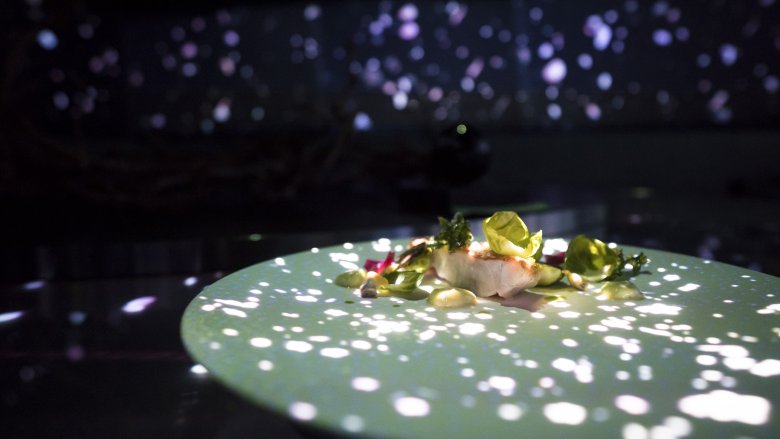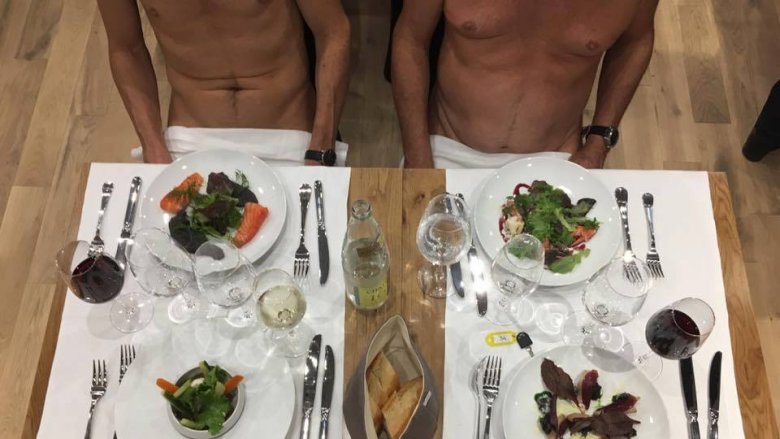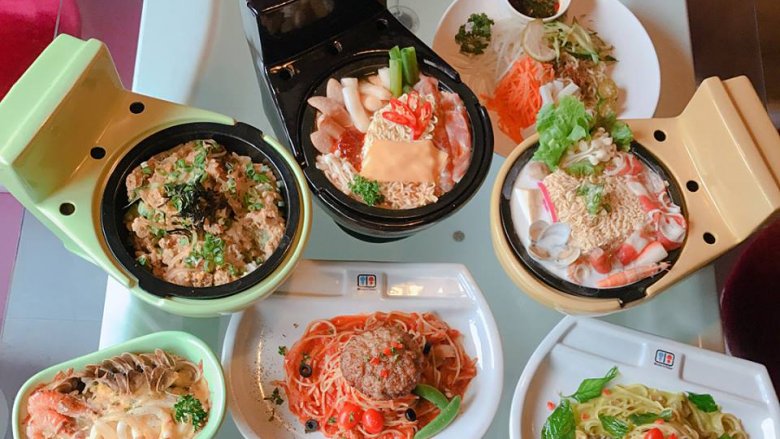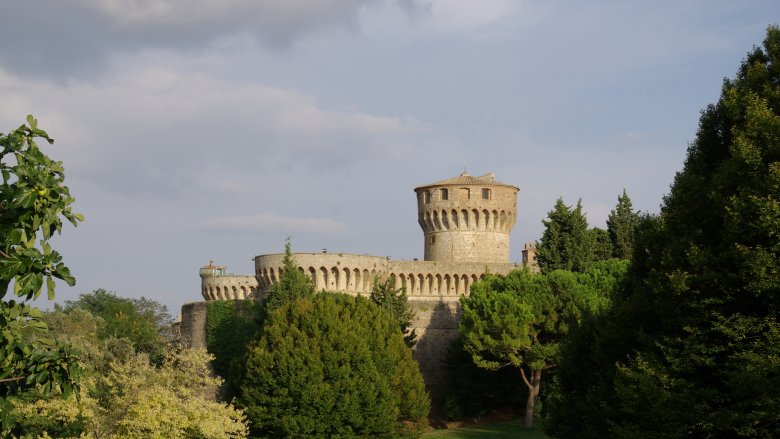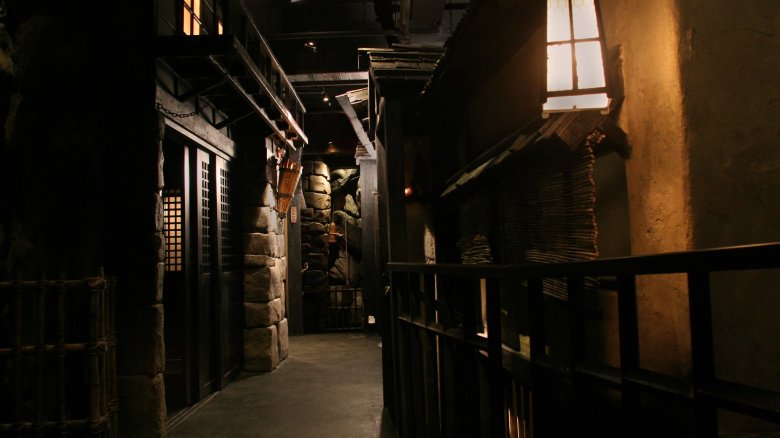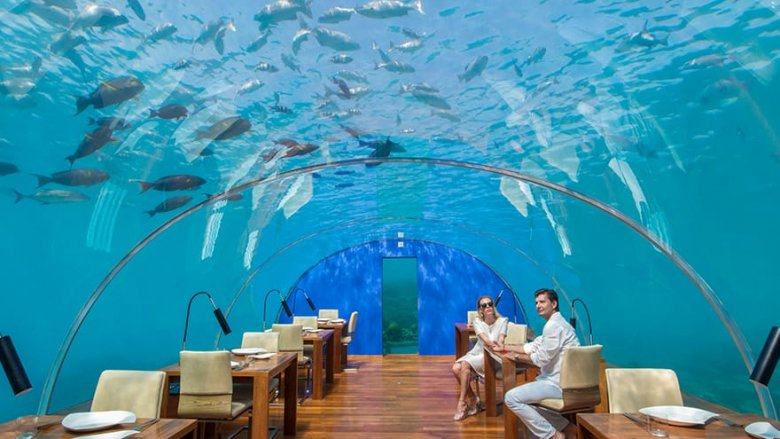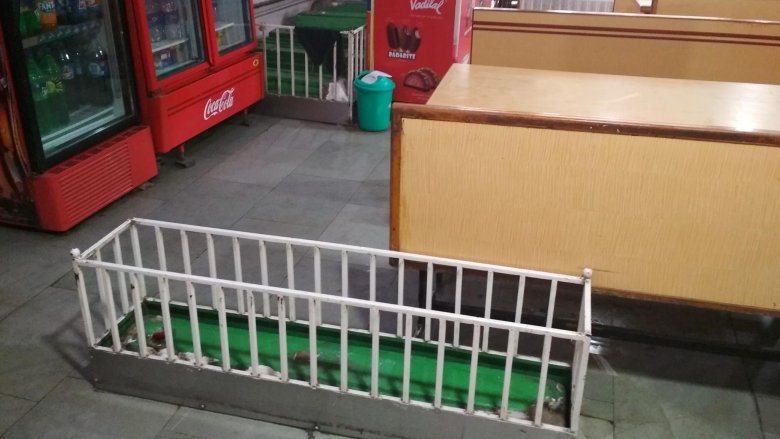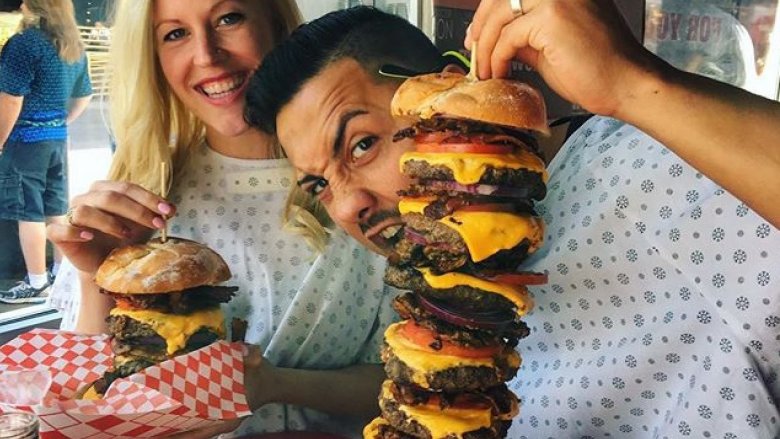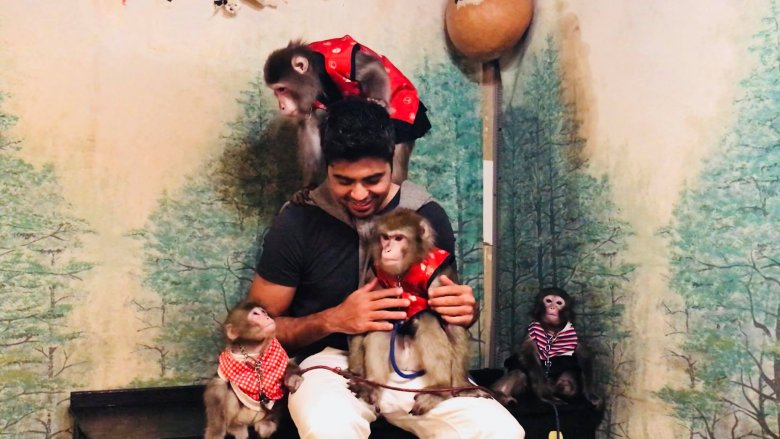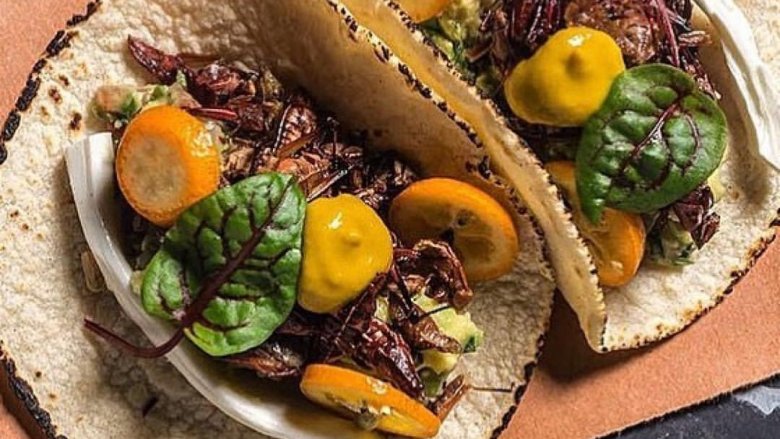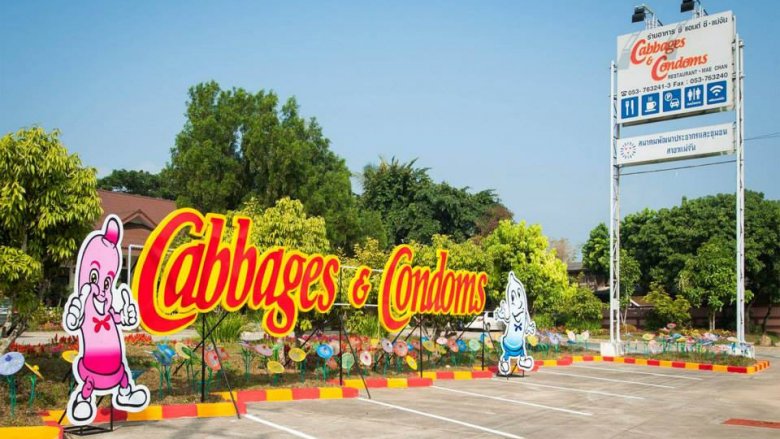Strange Restaurants You Never Knew Existed
Like the fashion photographer, the mandolin player, and humble blogger, the chef is, at his or her core, an artist.
It's no surprise, then, that the restaurant industry is a hotbed for creativity, innovation — and sometimes total weirdness. Consider, for example, the trend of Nyotaimori, the practice of eating sushi off a naked woman's body, introduced by geisha house kitchens back in 1600s Japan. Or the fondue craze, a Swiss tradition involving melting stale bread into vats of melted cheese, that hit U.S. restaurants in the 1970s? And who could forget the Flamin' Hot Cheetos trend that swept Los Angeles a few years ago?
Today, you can dine with cats, dine in the dark, or dine hoisted 150 feet in the air by a crane at restaurants around the world. But even if you're a seasoned foodie who eats only eats Flamin' Hot Cheetos off naked women in the dark while suspended by a crane, we bet you never knew these strange restaurants existed...
O'Naturel: Paris, France
At O'Naturel, a fancy French bistro in the 12th Arrondissement of Paris, France, the dress code is pretty strict. No cut-off shorts and flip-flops, obviously. No T-shirts or sweatpants allowed, either. But suits, ties, cocktail dresses, suspenders, sombreros, and Darth Vader masks are also prohibited. For you see, the aptly named O'Naturel is a "naturist" restaurant—the first no-fashion-allowed restaurant in all of Paris, the fashion capital of the world.
That's right: In order to get a table at O'Naturel, you need to make an advanced reservation and leave all your clothing in a locker room outside the dining room. The dining room itself is shielded from the gaze of curious passerby by blackout curtains, and the elegant chairs feature black slipcovers that are exchanged between guests for hygiene purposes.
In the whole 40-seat restaurant, the only people clothed are the servers and cooks, who must remain clothed per French laws. You, on the other hand, are free to sit at your table, place your napkin on your nap, and feast on a menu of roasted snail, lamb chops, creme brulee, and other fine French delicacies, completely nude.
Modern Toilet Restaurant: Taiwan and China
When it comes to restaurants that aren't afraid to risk shocking, disturbing, and even repelling some guests, Modern Toilet, a bathroom-themed restaurant chain, takes the [urinal] cake. Since it launch in Taiwan, in 2006, the chain has been "on a roll," expanding to locations around Taiwan and China. You'd think a restaurant based around poop, debatably the least appetizing concept imaginable, would end up in the toilet — but the restaurant is reportedly drawing thousands of brave guests per day. Ok, no more bathroom puns, we promise.
Modern Toilet applies its potty theme to everything from the decor to dessert. Guest sit on acrylic toilets at glass tables, basked in the glow of light from plunger lamps with poop-shaped bulbs. The walls are glittery bathroom tile mosaics depicting stick figures on the toilet and shower-heads hang from the ceilings. Beverages are served in a souvenir plastic urinal cup, while food comes either in a tiny toilet or tub. For party poopers (sorry, last pun, we swear), folding chairs and non-toilet-themed serveware are available upon request.
Everything served on the menu is poop-themed, from the handmade "sh*tballs (meatballs) to the spicy toilet beef curry to the green dysentery (kiwi) shaved ice dessert. "It's supposed to shock and confuse the senses," Modern Toilet manager Chen Min-kuang explained to Time.
Chen Min-kuang? Consider that bowl, uhh ... goal accomplished.
Fortezza Medicea: Volterra, Italy
There are two ways into Fortezza Medicea, an exclusive restaurant in Volterra, Italy. 1) You can commit a crime that results in a sentence for longer than seven years. 2) You can make a reservation.
Housed in a 13th-century castle that serves as high-security prison, Fortezza Medicea is staffed entirely by some of Italy's most hardened criminals serving seven years to life. The restaurant began as a social experiment in 2006 to allow inmates the opportunity to gain job skills and interact with the world beyond the prison walls. Inmates, trained by guest chefs, handle everything from the cooking to the pouring of prosecco.
Before you can enter the restaurant, you must provide I.D., hand in your cellphone, and pass through a metal detector. As guards patrol the perimeter, a gourmet Italian dinner is served in the prison's former chapel beneath high walls, watch towers, and security cameras. Unfortunately, this truly one-of-a-kind experience only happens eight nights a year. And a stringent background check and approval from the Italian Department of Justice are all required for that reservation we mentioned.
Ninja New York: New York City
In a city renowned for being jaded, Tribeca restaurant Ninja New York still manages to surprise — and sometimes terrify.
There's just something about weapon-wielding ninjas jumping out of hidden doors and materializing out of puffs of smoke while you're trying to eat chicken teriyaki that can be alarming. And that's exactly what the waitstaff at Ninja New York are trained, paid, and tipped 20 percent of your total bill to do.
Ninja New York is based in a subterranean space decorated to look like a feudal-era Japanese village, with dark, winding corridors, ornate woodwork, and stone walls. When you first arrive, you are offered a choice of taking the "safe path" or the "dangerous ninja path" to your table. Spoiler alert: the "dangerous ninja path" involves a dimly-lit maze where a ninja or two may pop out at you and scare your pants off.
Once you arrive at your dungeon-like private dining chamber, the real fun begins. Your dinner, punctuated with surprise attacks from the wait staff, will include elaborately presented Japanese dishes. Think sushi, sashimi, and teriyaki presented with swords, explosions, and fire, all culminating at a magic show at the end.
Ithaa Undersea Restaurant: Rangali Island, Maldives
Deep down in the Indian Ocean, amid coral reefs where colorful fish play, sits the Ithaa Undersea Restaurant. The world's first underwater restaurant is a curved, acrylic building that treats guests to a 180-degree panoramic view of the surrounding ocean.
Engineered by the Kuala Lumpur National Science Center, the Ithaa is a mostly-acrylic undersea eatery and the world's largest aquarium tunnel. It was built in Singapore and shuttled on a massive ocean barge to Maldives, a tropical country in the Indian ocean renown for white-sand beaches and impossibly blue waters. There, it was lowered 16 feet into the sea off the shore of the Conrad Maldives Rangali Island Resort.
Beneath the envious glare of stingrays, sharks, sea turtles, smartly dressed diners sip cocktails over Maldivian fusion cuisine. The ever-updating menu features dishes plucked fresh from the sea, with super fancy-sounding treats like Oscietra caviar and squid-ink miso-dashi consume.
To experience this deep-sea dining room for yourself, you'll need to take an hour-long seaplane ride from the main Male International Airport in Maldives and reserve your seat in advance. Act quickly—because the Ithaa is being crushed by the Indian Ocean as we speak, the restaurant isn't expected to last more than 20 years.
The New Lucky Restaurant: Ahmedabad, India
When life gives you lemons, you make lemonade. When life gives you an old Muslim cemetery, you make a restaurant.
That's what Krishnan Kutti did, anyway. When he decided to expand his tea stand into a restaurant, he didn't let the fact that the property next door was a graveyard discourage him. Instead, Kutti constructed his restaurant around the hulking, casket-like tombstones, installing steel bars so customers don't accidentally trample the dead. Kutti believes that the coffins are good luck, assuring the Associated Press, "Our business is better because of the graveyard".
Every morning, the restaurant staffers wipe down and place fresh flowers by the graves, which some believe hold the followers of a 16th century Sufi saint. Customers are ushered around tombstones to tables, where they can dine on South Indian cuisine in the company of the dead. Reviewers rave about the chai tea and cheese bun maska, an iconic fluffy Indian bread.
Heart Attack Grill: Las Vegas, Nevada
Never mind the fact that heart disease is the leading cause of death in America, a nation currently in the grip of a growing obesity epidemic. The Heart Attack Grill, a hospital-themed restaurant in downtown Vegas, is unashamed about its glorification of the unhealthy diet. The restaurant is staffed by scantily clad, sexy nurses, who serve up massive burgers to "patients," as they refer to their customers.
The menu features massive burgers with up to four pounds of beef. The Quadruple Bypass Burger is drowned in chili and packs a staggering 9,983 calories, enough calories to comfortably feed five grown men for the whole day. Other options include fries sizzled in lard, butterfat milkshakes, massive chili dogs, and candy cigarettes for the youngsters.
Weigh over 350 pounds? You're in luck! Just step on that electronic cattle scale to prove it, and you'll get all-you-can-eat food, free of charge! Can't finish your entire meal? You're out of luck — one of the sexy nurses gets to give you a spanking. Somehow, the restaurant has remained open and unabashed, even after their 575-pound spokesperson died and a customer had a heart attack while eating there.
Kayabukiya Tavern: Utsunomiya, Japan
An hour north of Tokyo in a town called Utsunomiya, there's a traditional, family-run sake house called Kayabukia Tavern. The tavern is run by Kaoru Otsuka, who started the business in the late '80s.
One fateful evening a few years after opening the restaurant, Otsuka took his pet macaque monkey, Yat-chan, to work, and the monkey watched him carefully. After seeing the delight on the customer's face when Yat-chan handed her a hot oshibori towel for her hands, something he had seen Otsuka do repeatedly, he was inspired to hire a whole cocktail waitstaff of macaque monkeys.
Today, five monkeys work at the restaurant alongside human servers. Their human coworkers handle the barbecue chicken and dumplings, while the monkeys are charged with doling out bottles of beer and hand towels. Dressed in checkered waiter outfits, they also perform tricks with drums, masks, stilts, and hoops. The inner animal rights activist within you might be squirming right now, but—if it makes you feel better—the monkeys work a maximum of two hours a day and are rewarded in tips of boiled soybeans.
The Black Ant: New York City
If you are among the two billion people in the world who regularly consume insects, The Black Ant NYC might not seem strange at all to you. But for much of the Western world, unfamiliar and uneasy about the concept of bugs as a food source, the menu of this hip East Village eatery might initially seem a little creepy crawly.
The Black Ant specializes in insects — not just ants, but grasshoppers and worms too. At the Mexican-inspired eatery, you can start off with an order of guacamole with black ant salt, followed by tacos made with shrimp encrusted in grasshoppers. Then, you can wash it all back with a smokey jalapeno margarita with black-ant salt rimming the glass.
Think bugs are yucky? There's also a selection of non-buggy apps and entrees inspired by the cuisines of Mexico and the Dominican Republic. But before you turn up your nose at those crispy grasshopper tacos, consider that insects are a high-protein, low-fat, sustainable food source.
Cabbages & Condoms: Thailand, Japan, and England
Cabbages & Condoms is a restaurant dedicated to that well-known circle of rubbery contraception: the condom. There are life-size mannequins dressed up in everything from condom beards to codom ballgowns. There are elegant arrangements of condom flowers on the tables and condoms are handed out in lieu of mints. Amid rubbery trimmings, Cabbages & Condoms restaurants dish out authentic Thai cuisine that "won't make you pregnant," as their motto proclaims.
But the condom decorations and non-empregnating cuisine are more than just a quirky theme. To truly understand the restaurant's contraception concept, we have to go back to 1970s, Thailand, when the average number of children for a Thai family was seven. Mechai Viravaidya, chairman of Thailand's Population & Community Development Association (PDA), was concerned about his country's out-of-control population growth and widespread lack of access to contraception.
At the time, you could find cabbages in any store around Thailand, Viravaidya mused. "Condoms should be like cabbages which are ubiquitous and accessible to everyone," he boldly proclaimed.
In addition to spearheading education initiatives, Viravaidya was inspired to start a small vegetable stand on the grounds of the PDA office, which sold veggies, condoms, and oral contraceptives. Since its origins as a humble vegetable stand, Cabbages & Condoms has blossomed into a highly-acclaimed restaurant with international locations. Meanwhile, Thailand's population growth has plummeted and "Mechai" has become a Thai slang for "condom".
